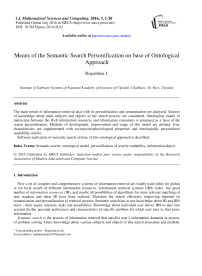Means of the Semantic Search Personification on base of Ontological Approach
Автор: Rogushina J.
Журнал: International Journal of Mathematical Sciences and Computing(IJMSC) @ijmsc
Статья в выпуске: 3 vol.2, 2016 года.
Бесплатный доступ
The main trends of information retrieval deal with its personification and semantization are analyzed. Sources of knowledge about main subjects and objects of the search process are considered. Ontological model of interaction between the Web information resources and information consumers is proposed as a base of the search personification. Methods of development, improvement and usage of this model are defined. User characteristics are supplemented with sociopsychophysiological properties and ontologically personalized readability criteria. Software realization of semantic search on base of this ontological approach is described.
Semantic search, ontological model, personification of search, readability, information object
Короткий адрес: https://sciup.org/15010209
IDR: 15010209
Список литературы Means of the Semantic Search Personification on base of Ontological Approach
- Lawrence, S. Context in the Web Search. – http://citeser.nj.nec.com/ lawrence00context.html.
- Gladun, A., Rogushina, J., Valencia-García, R., Martínez-Béjar, R. (2013) Semantics-driven modelling of user preferences for information retrieval in the biomedical domain. Informatics for health and social care, 2, 150-170.
- Gladun, A., and Rogushina, J. (2007) Formalization of Search Context on Base of Ontologies and Multilinguistic Thesauruses. Computing, v.6, issue 3, 16-22.
- Gladun, A., Rogushina, J. (2009) Use of Semantic Web technologies in design of informational retrieval systems. Building and Environment, Nova Scientific Publishing: 89-103.
- Fazzingaa B., Lukasiewiczb T. (2010) Semantic search on the Web. Semantic Web – Interoperability, Usability, Applicability: 1-7.
- Corby O., Dieng-Kuntz R., Faron-Zucker C. (2004) Querying the Semantic Web with Corese search engine. Proc. ECAI-2004, IOS Press: 705-709.
- Finin T. W., Ding L., Pan R., Joshi A., Kolari P., Java A., Peng Y. (2005) Swoogle: Searching for knowledge on the Semantic Web.Proc. AAAI-2005: 1682-1683.
- Lei Y., Uren V. S., Motta E. (2006) SemSearch: A search engine for the Semantic Web. Proc. EKAW-2006: 238-245.
- Tran T., Cimiano P., Rudolph S., Studer R. (2007) Ontology- based interpretation of keywords for semantic search. Proc. ISWC/ASWC-2007:523-536.
- Damljanovic D., Agatonovic M., Cunningham H. (2010) Natural language interface to ontologies: Combining syntactic analysis and ontology-based lookup through the user interaction. Proc. ESWC-2010, Part I: 106-120.
- Fernandez M., Lopez V., Sabou M., Uren V. S., Vallet D., Motta E., Castells P. (2008) Semantic search meets the Web. Proc. ICSC-2008: 253-260.
- Mangol C. (2007) A survey and classification of semantic search approaches. International Journal of Metadata, Semantics and Ontologies, N 2(1):P.23-34.
- Types of psychological tests for psychologists, mental health professionals and educators. – http://www.assessmentpsychology.com/tests.htm
- Murphy, K. R., Davidshofer, C. O. (1998) Psychological testing. Principles, and Applications, Englewood Cliffs. – http://tocs.ub.uni-mainz.de/pdfs/058927786.pdf.
- Quinlan, J.R. (1979) Discovery rules from large collections of examples: a case study. Expert Systems in the Microelectronic Age: 87-102.
- Gladun, A., Rogushina, J. (2012) Use of Semantic Web Technologies and Multilinguistic Thesauri for Knowledge-Based Access to Biomedical Resources. International Journal of Intelligent Systems and Applications, №1: 11-20. – http://www.mecs-press.org/ijisa/ijisa-v4-n1/IJISA-V4-N1-2.pdf.
- Rogushina, J., Gladun, A. (2006) Ontological Approach to Domain Knowledge Representation for Informational Retrieval in Multiagent Systems. Information Theories & Applications, V.13, N.4: 354-362.
- Readability. – https://en.wikipedia.org/wiki/Readability.
- Bormuth, J. R. (1967) Development of Readability Analysis. – http://files.eric.ed.gov/fulltext/ED029166.pdf.
- Miles, T. H. (1990) The fog index: a practical readability scale. Critical Thinking and Writing for Science and Technology: 280-284. – http://www.as.wvu.edu/~tmiles/fog.html.
- Flesch Reading Ease Readability Formula. – http://oleandersolutions.com/fleschreadingease.html.
- Long, A. Calculating Reading Level. Tameri Guide for Writers. – www.tameri.com/edit/levels.html.
- Coleman-Liau Index http://en.wikipedia.org/wiki/Coleman-Liau_Index.
- Raygor Readability Estimate – http://en.wikipedia.org/wiki/Raygor_Estimate_Graph.
- Powers, R. D., Sumner, W. A., Kearl B. E. (1958) A recalculation of four adult readability formulas. Journal of Educational Psychology, 49.2: P.99-105.
- McLaughlin, H. (1969) SMOG grading – a new readability formula. Journal of Reading, N 22: 639-646.
- Sticht, T. G. (1973) Research towards the design, development and evaluation of a job-functional literacy training program for the US Army, Literacy Discussion, N 4: 339-369.
- Ricci, F., Rokach, L., Shapira, B., Kantor P. Recommender Systems Handbook. – Springer, 2011. – 842 p.
- Rogushina, J., Gladun, A. (2012) Ontology-based competency analyses in new research domains Journal of Computing and Information Technology, 20 (4): 277-291.
- Rogushina J. (2016) Use of the Ontological Model for Personification of the Semantic Search. International Journal of Mathematical Sciences and Computing(IJMSC), Vol. 2, N 1: 1-15.


